Plot
This article needs a plot summary.(June 2022) |
| The Final Comedown | |
|---|---|
| Directed by | Oscar Williams |
| Written by | Oscar Williams |
| Produced by | Edgar Charles Roger Corman Mel Taylor Oscar Williams |
| Starring | Billy Dee Williams D'Urville Martin Celia Kaye Billy Durkin Raymond St. Jacques |
| Cinematography | William B. Kaplan |
| Edited by | Dick Van Enger Jr. |
| Music by | Grant Green Wade Marcus |
| Distributed by | New World Pictures |
Release date |
|
Running time | 83 minutes |
| Country | United States |
| Language | English |
| Budget | $26,500 [1] |
The Final Comedown is a 1972 blaxploitation drama film written, produced and directed by Oscar Williams and starring Billy Dee Williams and D'Urville Martin. The film is an examination of racism in the United States and depicts a shootout between a radical black nationalist group and the police, with the backstory leading up to the shootout told through flashbacks. The radical group is not identified by name in the film but closely resembles the Black Panther Party.
The film was recut and re-released in 1976 under the title Blast! The new version, which credited "Frank Arthur Wilson" as the director, featured additional footage directed by Allan Arkush. [2]
The original version has had several releases on DVD from various budget-line DVD manufacturers.
This article needs a plot summary.(June 2022) |
Roger Corman put up $15,000 of the film's budget. [1]

Roger William Corman is an American film director, producer, and actor. Known under various monikers such as "The Pope of Pop Cinema", "The Spiritual Godfather of the New Hollywood", and "The King of Cult", he is known as a trailblazer in the world of independent film. Many of Corman's films are low-budget cult films including some which are adapted from the tales of Edgar Allan Poe.

William December Williams Jr. is an American actor, novelist and painter. He has appeared in over 100 films and television roles over six decades. He is most known for portraying Lando Calrissian in the Star Wars franchise and has also appeared in critically acclaimed and popular titles such as Mahogany (1975), Scott Joplin (1977), and Nighthawks (1981), as Harvey Dent in Batman (1989) and The Lego Batman Movie (2017), The Last Angry Man (1959), Carter's Army, The Out-of-Towners (1969), The Final Comedown and Lady Sings the Blues, Hit! (1973), Fear City and Terror in the Aisles, Alien Intruder (1993) or The Visit (2000).
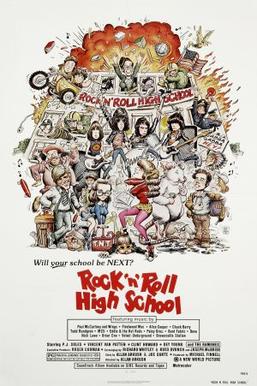
Rock 'n' Roll High School is a 1979 American musical comedy film directed by Allan Arkush, produced by Michael Finnell, and starring P. J. Soles, Vince Van Patten, Clint Howard and Dey Young. The film features the punk rock group Ramones.

Boxcar Bertha is a 1972 American romantic crime drama film directed by Martin Scorsese and produced by Roger Corman, from a screenplay by Joyce H. Corrington and John William Corrington. Made on a low budget, the film is a loose adaptation of Sister of the Road, a pseudo-autobiographical account of the fictional character Bertha Thompson. It was Scorsese's second feature film.
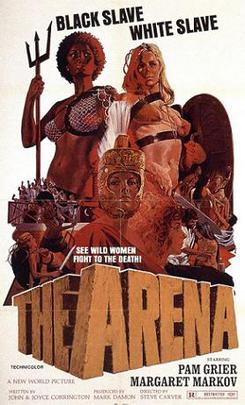
The Arena, also known as Naked Warriors, is a 1974 gladiator exploitation film directed by Steve Carver and starring Margaret Markov and Pam Grier. Joe D'Amato, the film's cinematographer, has stated that he took over direction of the fight scenes in the film.

Dementia 13, known in the United Kingdom as The Haunted and the Hunted, is a 1963 independently made black-and-white horror-thriller film produced by Roger Corman, and written and directed by Francis Ford Coppola in his feature film directorial debut. The film stars William Campbell and Luana Anders with Bart Patton, Mary Mitchell, and Patrick Magee. It was released in the United States by American International Pictures during the fall of 1963 as the bottom half of a double feature with Corman's X: The Man with the X-ray Eyes.
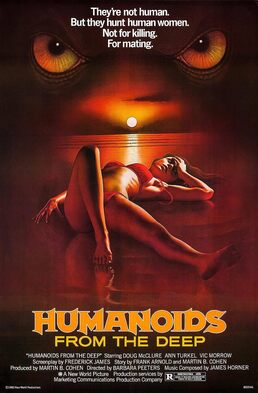
Humanoids from the Deep is a 1980 American science fiction horror film starring Doug McClure, Ann Turkel, and Vic Morrow. Roger Corman served as the film's uncredited executive producer, and his company, New World Pictures, distributed it. Humanoids from the Deep was directed by Barbara Peeters and an uncredited Jimmy T. Murakami.
Teenage Caveman is a 1958 American independent black-and-white science fiction adventure film produced and directed by Roger Corman, and starring Robert Vaughn and Darah Marshall. The film was released by American International Pictures in July 1958 as a double feature with How to Make a Monster.

Gas-s-s-s is a 1970 post-apocalyptic black comedy film produced and released by American International Pictures.

Bloodfist is a 1989 American martial arts film directed by Terence H. Winkless, starring Don "The Dragon" Wilson, Rob Kaman, Billy Blanks and Cris Aguilar. The plot sees an American former kickboxer travel to Manila, where he re-enters competition to avenge the murder of his brother and fellow fighter.

Let's Do It Again is a 1975 American action crime comedy film, starring Sidney Poitier and co-starring Bill Cosby and Jimmie Walker among an all-star black cast. The film, directed by Poitier, is about blue-collar workers who decide to rig a boxing match to raise money for their fraternal lodge. The song of the same name by The Staple Singers was featured as the opening and ending theme of the film, and as a result, the two have become commonly associated with each other. The production companies include Verdon Productions and The First Artists Production Company, Ltd., and distributed by Warner Bros. The movie was filmed in two cities, Atlanta, Georgia and New Orleans, Louisiana, where most of the plot takes place. This was the second film pairing of Poitier and Cosby following Uptown Saturday Night, and followed by A Piece of the Action (1977). Of the three, Let's Do It Again has been the most successful both critically and commercially. Calvin Lockhart and Lee Chamberlin also appeared in Uptown Saturday Night. According to the American Film Institute, Let's Do It Again is not a sequel to Uptown Saturday Night.
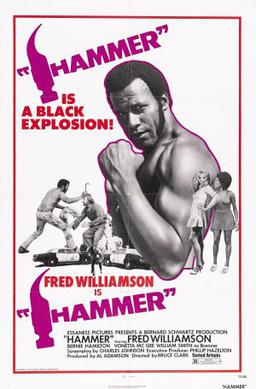
Hammer is a 1972 blaxploitation film directed by Bruce D. Clark. The film was released following the successes of Sweet Sweetback's Baadasssss Song and Shaft, notable 1971 films that popularized black cinema. It starred Fred Williamson as B.J. Hammer. Williamson went on to become a staple of the genre.
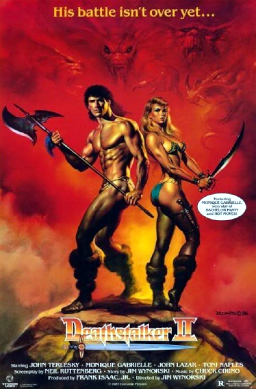
Deathstalker II, also known as Deathstalker II: Duel of the Titans, is a 1987 Argentine-American fantasy comedy-adventure film directed by Jim Wynorski and a sequel to 1983's Deathstalker. It was written by Neil Ruttenberg and starring John Terlesky, Monique Gabrielle, John LaZar and María Socas. Terlesky replaced Rick Hill, the protagonist from the previous film, in the starring role of Deathstalker. This is the last sword and sorcery movie that Roger Corman produced in Argentina during the 80s.

Galaxy of Terror is a 1981 American science fiction horror film produced by Roger Corman through New World Pictures and directed by Bruce D. Clark. It stars Edward Albert, Erin Moran, Ray Walston and Taaffe O'Connell. Set in a dystopian future where humanity is a spacefaring race ruled by a sole person called "The Master," the film features a space crew confronting primal fears after they are marooned on a distant planet.

Blaxploitation is an ethnic subgenre of the exploitation film that emerged in the United States during the early 1970s, when the combined momentum of the civil rights movement, the Black power movement, and the Black Panthers spurred black artists to reclaim power over their image, and institutions like UCLA to provide financial assistance for students of color to study filmmaking. This combined with Hollywood adopting a less restrictive rating system in 1968. The term, a portmanteau of the words "black" and "exploitation", was coined in August 1972 by Junius Griffin, the president of the Beverly Hills–Hollywood NAACP branch. He claimed the genre was "proliferating offenses" to the black community in its perpetuation of stereotypes often involved in crime. After the race films of the 1940s and 1960s, the genre emerged as one of the first in which black characters and communities were protagonists, rather than sidekicks, supportive characters, or victims of brutality. The genre's inception coincides with the rethinking of race relations in the 1970s.

Slaughter is a 1972 blaxploitation film directed by Jack Starrett and starring Jim Brown as a former Green Beret captain seeking revenge for a murder. Stella Stevens, Rip Torn, Don Gordon and Cameron Mitchell co-star. This film was followed by a sequel the following year, Slaughter's Big Rip-Off (1973).

Night Call Nurses is a 1972 American sex comedy film directed by Jonathan Kaplan. It is the third in Roger Corman's "nurses" cycle of films, starting with The Student Nurses (1970).
Target: Harry is a 1969 thriller film directed by Roger Corman.

Crazy Mama is a 1975 American action comedy film, directed by Jonathan Demme, produced by Julie Corman and starring Cloris Leachman. It marked the film debuts of Bill Paxton and Dennis Quaid.

I Escaped from Devil's Island is a 1973 exploitation film about an escape attempt from Devil's Island. Roger Corman and Gene Corman produced this grim adventure saga which was made to cash in on the release of Papillon.